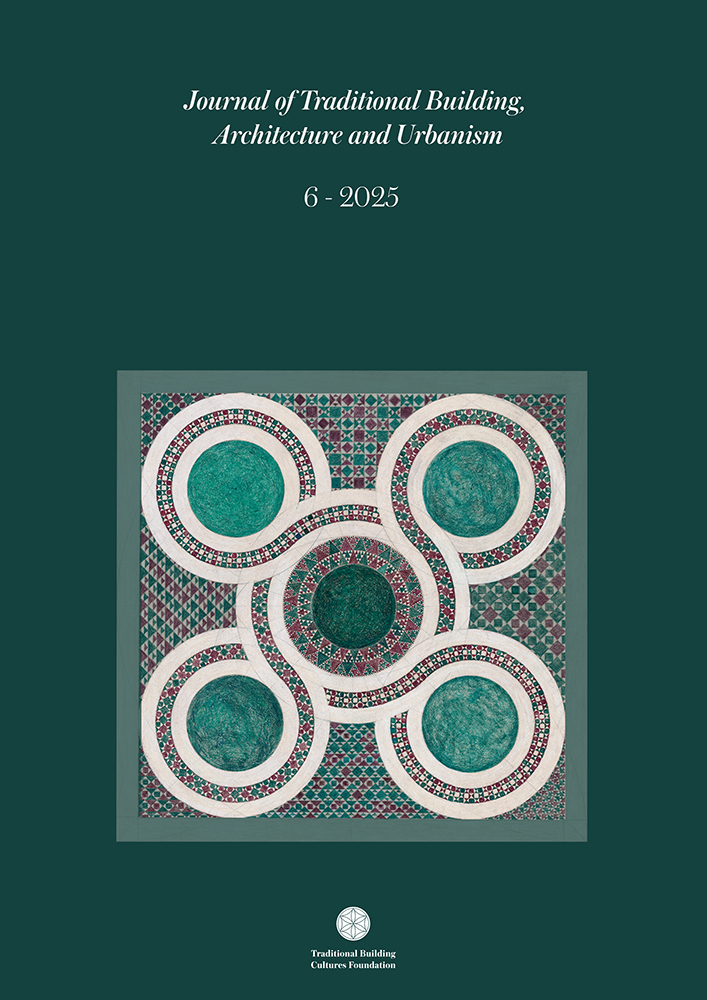Abstract
This paper presents a geometric analysis of four seventeenth-century Mughal buildings in an attempt to decipher the design methods used by Mughal architects to create their masterpieces. The geometric analysis is placed in the framework of the Hasht Bihisht (Eight Paradises) plan-form, the archetypal ground-plan of Mughal architecture. Categorized as a type of “nine-square mandala” diagram, the Hasht Bihisht is a symbol of the cosmos, i.e., a harmoniously created universe. Our findings are a continuation of those of scholars of Central Asian Timurid architecture and analogous to what is common to traditional architecture generally, down to our times, as will be shown through the work of a hereditary master mason. In conclusion, it is proposed that these design methods be interpreted in the light of traditional cosmology.
References
Begley, Wayne Edison; and Desai, Ziyaud-Din A. 1989. Taj Mahal: The Illuminated Tomb: An Anthology of Seventeenth-century Mughal and European Documentary Sources. Cambridge: Aga Khan Program for Islamic Architecture.
Bulatov, Mitxat Sagadatdinovich. 1978. Geometric Harmonisation in the Architecture of Central Asia, IX – XV Centuries. Moscow: Nauka Publishers.
Burckhardt, Titus. 1976. The Art of Islam Language and Meaning. London: World of Islam Festival Publishing Company.
Chughtai, Muhammad Abdullah. 1957. Ustad Ahmed Mimar Lahori and His Family. Lahore.
Coomaraswamy, Ananada Kentish. 1934. The Transformation of Nature In Art. New York: Dover Publications.
Crane, Howard. 1987. Ris?le-i mi?m?riyye: an early-seventeenth-century Ottoman treatise on architecture : Facsimile with translation and notes. Leiden: Brill.
Guenon, Rene. 1972 [1945]. Reign of Quantity and the Signs of the Time. London: Penguin Books.
Golombek, Lisa; and Wilber, Donald. 1988. The Timurid Architecture of Iran and Turan. Princeton University Press.
Holod, Renata. 1988. Text, Plan and Building: On the Transmission of Architectural Knowledge. In Sevcenko, Margaret Bentley (ed.), Theories and Principles of Design in the Architecture of Islamic Societies. Cambridge: Aga Khan Program for Islamic Architecture.
Internet Encyclopedia of Philosophy. Aquinas: Metaphysics. https://iep.utm.edu/thomas-aquinas-metaphysics. (consulted on 12/05/2025)
Jarrett, H.S. (tr.). 1949. Ain-i-Akbari of Abul Fazl-i-?Allami. Calcutta: Royal Asiatic Society of Bengal.
Jones, Mark Wilson. 2006. Ancient Architecture and Mathematics: Methodology and the Doric Temple. Nexus VI: Architecture and Mathematics, 6: 1-20.
Koch, Ebba. 1991. Mughal Architecture. Munich: Prestel–Verlag.
Koch, Ebba. 2006. The Complete Taj Mahal and the Riverfront Gardens of Agra. London: Thames and Hudson 2006.
Leonardis, Rocco. 2016. Geometry in Greece The Use of Geometry by Ancient Greek Architects. In Miles, Margaret M. (ed.), A Companion to Greek Architecture. New York: John Wiley & Sons.
Meister, Michael W. 1985. Measurement and Proportion in Hindu Temple Architecture. Interdisciplinary Science Reviews, 10, 3: 248-258.
Nasr, Seyyed Hosein. 1978. An Introduction to Islamic Cosmological Doctrines. London: Thames & Hudson.
Necipoglu, Gulru. 1996. The Topkapi Scroll: Geometry and Ornament in Islamic Architecture. Los Angeles: Getty Publications.
Neihardt, John G. 1972. Black Elk Speaks, Being the Life Story of a Holy Man of the Oglala Sioux. New York: Washington Square Press.
Rossi, Corinna. 2007. Architecture and Mathematics in Ancient Egypt. Cambridge: Cambridge University Press.
Sevcenko, Margaret Bentley (ed.). 1988. Theories and Principles of Design in the Architecture of Islamic Societies. Cambridge: Aga Khan Program for Islamic Architecture.
Smith, Wolfgang. 1995. The Quantum Enigma, Finding the Hidden Key. New York: Angelico Press.
Stanford Encyclopedia of Philosophy. 2022. Thomas Aquinas. https://plato.stanford.edu/entries/aquinas/#FormMatt (consulted on 12/05/2025)
Stoddart, William. 1993. Outline of Hinduism. Bloomington: Foundation for Traditional Studies.
The Metropolitan Museum of Art. Architectural Drawing of a Garden. https://www.metmuseum.org/art/collection/search/544801 (consulted on 18/04/2025)
Ustad, Rahim Bakhsh. 1970s. Handbook of Assorted Architectural Drawings. Unpublished.
Wittkower, Rudolf. 1973. Architectural Principles in the Age of Humanism. London: Academy Editions.

This work is licensed under a Creative Commons Attribution-NonCommercial-NoDerivatives 4.0 International License.

